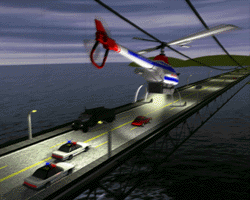Goal Mission Applications
|
Search & Rescue
|
- Vision-guided robot helicopters can quickly and systematically search
a very large area to locate victims of an accident or a natural disaster.
They can then visually lock on to objects at the site or stranded victims
to guide
rescue forces to the scene.
- They can help focus the efforts of search and rescue crews to the rescue
operation instead of the time consuming search operation.
- They can be more readily deployed in weather conditions which would
normally prevent human piloted search and rescue.
- They can be sacrificed in very dangerous conditions to save human lives.
Prime examples include flying close to a forest fire to look for stranded
individuals, searching in contaminated areas, and identifying potential
radioactive leaks after a nuclear reactor accident.
|

|
Surveillance
|
- Vision-guided robot helicopters can patrol an area and report interesting
or unusual activity. They can perform a variety of surveillance operations
ranging from
around-the-clock border patrolling to looking over the hill for potential
danger on the battle field.
- They can keep watch on an area non-stop by automatically landing and
refueling from ground stations in or near the area.
- They can automatically locate and identify suspicious activity and visually
lock-on to objects or persons involved until ground forces arrive.
|

|
Law Enforcement
|
- Vision-guided robot helicopters can fly overhead to aid the police in
dangerous high-speed chases or criminal search operations.
- Stationed on top of buildings in urban areas, they can be dispatched in
seconds to takeoff and relay images from trouble spots. This real time
imagery is crucial to the tactical assessment of the situation by human experts
who dispatch police units to the area.
|

|
Inspection
|
- Vision-guided robot helicopters can inspect high voltage electrical
lines in remote locations.
- They can inspect large structures such as bridges and dams cost
effectively.
- They can be quickly called upon to inspect buildings and roads for
potential damage after an earthquake.
- They can locate hazardous materials in waste sites by providing aerial
imagery to human experts or by automatically identifying waste containers or
materials by on-board vision.
|

|
Aerial Mapping
|
- Vision-guided robot helicopters can build more accurate topological maps
than conventional aircraft at a substantial cost savings.
- Unlike airplanes, they can fly close to the ground while carrying cameras
or
range sensors to build high resolution 3D maps.
- They can fly in smaller and more constrained areas to build highly
detailed elevation maps.
|

|
Cinematography
|
- Vision-guided robot helicopters can be a director's eye-in-the-sky
camera.
- They can fly precisely under computer control which eliminates
the need for skilled human pilots for aerial photography.
- They can automatically track subjects with their on-board vision-based
object trackers.
- They can fly a prescribed path over and over again to help plan shots
or to aid in producing special effects.
|

|





